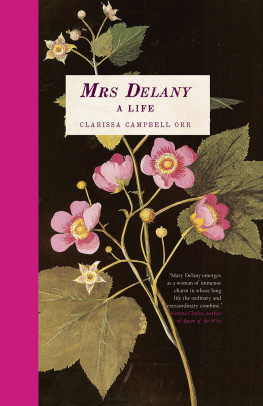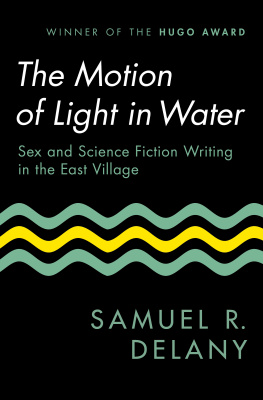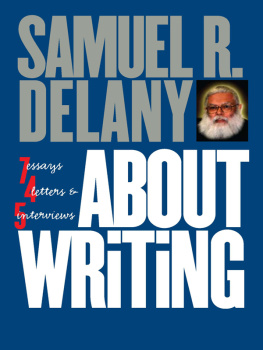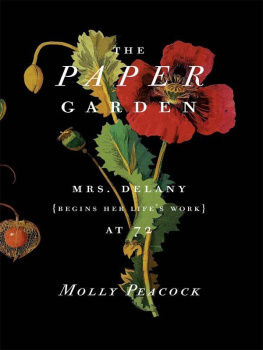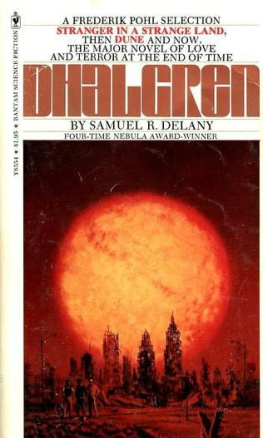MRS DELANY

Published with assistance from the Annie Burr Lewis Fund.
The publisher is grateful to those who have given permission to reproduce works illustrated in this book. Any omissions are inadvertent and will be corrected in future editions if notification is given to the publisher in writing.
Copyright 2019 Clarissa Campbell Orr
All rights reserved. This book may not be reproduced in whole or in part, in any form (beyond that copying permitted by Sections 107 and 108 of the U.S. Copyright Law and except by reviewers for the public press) without written permission from the publishers.
For information about this and other Yale University Press publications, please contact:
U.S. Office:
Europe Office:
Set in Van Dijck MT by IDSUK (DataConnection) Ltd
Printed in Great Britain by Gomer Press Ltd, Llandysul, Ceredigion, Wales
Library of Congress Control Number: 2019941046
ISBN 978-0-300-16113-7
A catalogue record for this book is available from the British Library.
10 9 8 7 6 5 4 3 2 1
Contents
Illustrations
PLATES BETWEEN PAGES 146147
PLATES BETWEEN PAGES 242243
Acknowledgements
T hroughout my academic career at the various incarnations of Anglia Ruskin University, I wrote numerous essays, articles, and entries to reference works, and edited, and was included in, several collections; but until Mrs Delany re-entered my life in the late summer of 2009, I had never written a monograph or contemplated a biography, in spite of quite a lot of my essays being built around a single figure. It seems appropriate now to acknowledge a few of the people whose example and advice led me to this exception that proves the rule, as well as mentioning gratefully the help and collegiality which have brought this project to fulfilment.
The first person I should mention is a teacher whose name I no longer remember, and who was not an historian or writer of any kind. For sixth form I attended Kings High School for Girls in Warwick yes, the female counterpart to the school attended by Mrs Delanys three nephews. It was re-founded in 1879 to add to the number of grammar-type schools for girls who wanted the same or nearly the same grounding in mathematics, classics and the sciences as their brothers had been receiving since AD 914. On Friday afternoons we were allowed to choose between art, music, sport and needlework; I chose the latter. We were not required to sew the same garment but whatever we had chosen, we had to make it to the highest standards of our teacher, who gave us plenty of expert tips. I was soon making a matching coat and dress for a family wedding; I can still recall the particular shade of blue I chose. But I took a short cut with the lining causing the top and bottom colour of the seams lining thread, which would be completely invisible when the garment was finished, to have a white as well as a blue thread. I had to undo this and start again with the correct colour on both pieces of material.
Well. This was a counsel of perfection! It made me realise that I might like the creative part best choosing pattern and cloth, cutting out and fitting but that you always need a third set of skills, the finishing off, and this is where I was inclined to tail off with a slapdash, wont this do?, attitude. But a benchmark had now been irreversibly set and, as skills are transferable, every piece of subsequent writing has made me switch gear into perfectionist mode and follow the guidance on referencing and bibliography required by different publishers. In the case of Yale I have been incredibly fortunate in a talented team. First came Marika Lysandrou, who kept a steady hand on the tiller throughout and quickly enlisted a typesetter when Microsoft upgraded and closed access to earlier versions. She also inaugurated the initial round of slimming my manuscript, and expertly advised on improving the Introduction. Rachael Lonsdale was an eagle-eyed and very patient editor, and Sophie Richardson not only sorted out systematic referencing but miraculously managed to shave off six words here and twenty words there to reach an appropriate word length when I could no longer see for looking. Finally, Matt James assisted with obtaining illustrations and permission to reproduce them.
Sparing the reader the full story of my intellectual formation at Kings High School, I will mention only that the sixth form culture encouraged wide reading and engagement with current affairs, just as Mme LePrince de Beaumont did for her pupils, as the reader will find out. One thing we debated vigorously was C.P. Snows essay on the two cultures, which made me recognise and regret how divided A-Levels were between the humanities and the sciences at that time. I was studying English, History and Latin at A-Level. But the literature curriculum was never restricted to a few set texts we didnt even read them until the second year so we all knew that Romanticism included a large number of writers, for instance Mary Shelley as well as her husband. (These days its the reverse: most students know a lot about Gothic literature and Frankenstein, but are barely aware of Percy Bysshe either as a poet or a literary critic.) Much later, my Anglia Ruskin colleague Professor Nora Crook roped me into helping edit Mary Shelleys essays on French literature, leading me to delve into the era of Louis XIV and letter-writers such as Mme de Svign, and many other writers of the seventeenth century that Mary Delany knew and loved.
At Kings High there was a cultural rebellion brewing against Oxford, which our headmistress had attended, and the Leavisite diet of Cambridge English i.e. literature and its cultural and historical background. I abandoned the goal of Law and reading for the Bar. Part I English proved something of a disappointment but I knew that a Part II option existed in History and Philosophy of Science, which proved a tremendous gateway to the more rounded kind of cultural history I had been seeking. Eventually, I had the enormous privilege of studying for a year with Professor R.A. Leigh, the editor of Jean-Jacques Rousseaus correspondence, and one of the greatest European scholars of his time. Who knew that his magnum opus would help me understand the attractions of Rousseau to Mrs Delanys brother so many years later, and show me that a decent immersion in a collected correspondence would include not only letters to and from the main subject but also between third parties about the main subject. At this point I barely knew what I was doing essentially a History of Science project so it was very daunting when Professor Leigh commented that if I admired Voltaire so much, why didnt I emulate his wit? Imagine! I was only about twenty-four at the time! However, here was a second example of extremely high standards, this time of scholarship rather than needlework. And it turned out that Professor Leigh was a great cat-lover, so that made him seem less daunting. I hope that some Attic salt does get sprinkled through the pages these days too.
Later academic debts are owed to Roy Porter, who made me write on Swiss Romanticism; Jane Rendall for her mentoring on womens history; Mary Abbott for introducing me to family history; Frances Harris and Elaine Chalus for illuminating conversations; Amy Meyers and Amanda Vickery for roping me into an exhibition, then inviting me to be a Senior Research Fellow, at Yale Center for British Art; Jonny Yarker at Lowell Libson & Jonny Yarker Ltd, for helping me understand the eighteenth-century art world as well as the contemporary one.
On a more personal note, there are many friends I need to thank not just for being friends, in many cases for a lifetime, but for their practical help and wisdom. Chronologically, the first was probably Helen Sykes, whom I have known since we were both recent graduates needing to find our footing in the world of work. She established herself in East Sheen and has been a long-time hostess when I visited my many friends in south-west London over the years. It dawned on me eventually that however hard I tried I would never feel fully at home in Cambridge, despite the many advantages there were for my professional role, such as a first-class research library for which I had borrowing rights a mere ten-minute cycle from my home, and a ten-minute walk to work. This was simply a geographical issue I never felt at home under East Anglian skies. Eventually I recognised this was incurable and one New Year, we discussed the fact I should do some research about selling up in Cambridge and relocating to the Thames Valley. Within a year this came about and there I was, warmly welcomed into her vibrant extended household and neighbourhood. This included the gentlemanly Obi and the hyper energetic rescue-cat Pixie, who was expected to grow up lean and lithe but somehow turned out a little fuller of figure.
Next page
